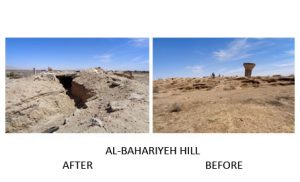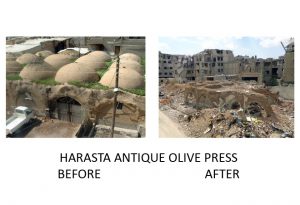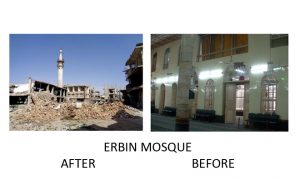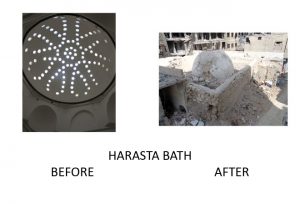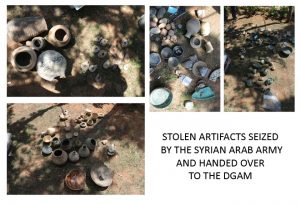Damascus, SANA- After the liberation of Eastern Ghouta from terrorist organizations such as Jabhat al-Nusra, Jaish al-Islam, and Failaq al-Rahman, SANA worked to collect as much information as possible regarding archeological sites in the area and document the destruction, damage, and looting that affected them.
The archeological sites which were outside the terrorist organization’s control remained safe, including al-Qareen hill, al-Ghizlanieh hills , and al-Fara hills, according to General Director of the Directorate General of Antiquities & Museums (DGAM), Dr. Mahmoud Hamoud.
He added that Aswad hill site was undamaged as well because terrorists did not remain in that area for long.
As for the sites that were in areas controlled by terrorists, Ferzat hill, aka al-Salihiye hill, is the most prominent of them and is one of the most important sites in the south of Syria. The site, located 17 km west of al-Nashabieh town, dates back to the third millennium BC, and is one of the sites which have been sustained the most damage, as terrorists carried out illegal excavations using heavy machinery and bulldozers, which led to the destruction of its contents and the its archeological layers, as well as the theft of the artifacts discovered in it, Hamoud said.
Al-Baharieh hill in Kafar Batna is an ancient building dating back to the fifth and fourth centuries BC, and it was also subjected to massive damage due to illegal excavations. Terrorists also dug tunnels and trenches inside al-Khatib and al-Dabaa hills which date back to the 4th and 1st centuries BC, respectively.
Hammoud added that al-Qariferh Hill, 30 km east of Damascus and west of al-Abbadeh village in al-Nashabieh, which dates back to the period extending from the modern Stone Age until the Roman era, was vandalized as terrorists bulldozed parts of it and its surroundings and set up barricades and earth barriers.
Ghouta has several archeological and historical buildings that require urgent maintenance as they were severely damaged due to the terrorists’ actions, including the Harasta bath and the nearby olive press, Director of Damascus Countryside Antiquities Department Jihad Abu Kahla told SANA.
He said that the olive press dates back to the 19th century, and was vandalized due to the terrorists’ acts, while the situation in the Harasta bath is better and it can be repaired.
Two other archeological sites are the Kafar Batna and Zamalka baths, which need urgent restoration intervention to prevent their collapse, in addition to Qibet al-Asafeer site in Adral al-Omalieh area which was damaged and some parts of it were destroyed.
The liberated towns in Ghouta contain a number of antique religious sites, including the columns in the town of Harran al-Awamid which was recently inspected by a team from the Antiquities Department, finding them in a good condition as they only need to be cleaned.
Erbin Mosque, which is over 200 years old and is located in the center of Erbin town 7 km northeast of Damascus, was intentionally vandalized and damaged by terrorists, as some people had once objected to listing it as an archeological site because they wanted to demolish it and build commercial projects in its strategically-positioned site.
In Eastern Qalamoun, the town of al-Dmair has an ancient temple dating back to the 3rd century AD, consisting of a high building full of beautiful carvings and ornaments, and terrorists looted most of its contents, and they also used it as a base and surveillance point, digging tunnels inside it.
One of the most famous archeological sites in the area is the synagogue in Jobar, which contained many valuable items, some of which were “lost” during the first years of the war on Syria, according to Hamoud.
Hamoud said that later, it was found out that the Israeli occupation commissioned terrorists to steal the items from the synagogue and smuggle them abroad.
He added that some of the least valuable items from the synagogue were uncovered by the Syrian Arab Army as they were stashed away by terrorists, and now they are safe in the warehouses of the National Museums.
Hammoud clarified that there are continuous communications with Interpol, saying “We are satisfied with the good cooperation with the organization, but I say frankly that the smuggled antiquities do not pass through lawful or legitimate gates in every country being an illegal trade just like drugs, therefore their dealers seek other outlets to reach European countries.” “Restoring these pieces is difficult because they cannot be displayed in public places, ” he added.
“Legal files should be made for those who were proved to have smuggled or destroyed antiquities in case their identities were disclosed so that they could be sued worldwide,” said Hammoud.
A few days ago, Turkish media reported that the Turkish police arrested two people from Failaq al-Rahman terrorist group who had been attempting to smuggle manuscripts from the oldest synagogue in Syria, including two ancient copies of the Torah that predate the birth of Christ.
In order to recover the stolen artifacts, a bureau was established to contact various international sides in order to locate and reclaim the artifacts smuggled outside the country.
The continuously inhabited Damascus and its Ghouta lie on layers of archeological sites belonging to different historic eras, that are waiting to be discovered.
Shaza / Hazem Sabbagh
 Syrian Arab News Agency S A N A
Syrian Arab News Agency S A N A


